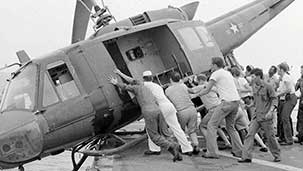Your job involved a very particular type of extraction. You were tasked to find filmed evidence to back up the stories told by people who lived through the harrowing final days before Saigon fell to the North Vietnamese. Some of this footage you sourced from authorities like the Big Three television networks, the National Archives and Associated Press, and some was supplied by the very people involved. Regardless of origin, it must have been difficult to make decisions about which footage stayed in the picture and which didn’t. No doubt there were many ways this story could have been told. In the end, you have to stand by the choices made by the filmmakers and hope that they’re the right ones.
Last Days In Vietnam chronicles the final weeks of the American involvement in the Vietnam War, and the chaotic, zero-hour evacuation of U.S. and South Vietnamese citizens from Saigon. It is told from the perspective of the people who were there, mainly the U.S. servicemen, CIA analysts, and pilots.
Like me, you must have inwardly rejoiced when you realized filmmaker Rory Kennedy wasn’t interested in investing any time in the Vietnam War’s exhausting origin story. What she wanted from you was right there in the title. With the exception of a few iconic images (helicopters being pushed off an aircraft carrier, desperate evacuees climbing a rickety ladder on what we learn was not the roof of the American embassy), most of the visuals you supply feel remarkably fresh.
Unfortunately, Kennedy’s pedestrian footage/talking head formula does not.
That’s not to say that the personal accounts described and depicted here aren’t thrilling in their own right. Most of the servicemen involved in helping people escape were acting against direct orders from American Ambassador Graham Martin, who refused to evacuate until Saigon was literally surrounded by the North Vietnamese Army. Your footage supports the servicemen’s play-by-play of how the situation worsened as the diplomatic foot-dragging forced those trapped to resort to the most desperate of measures.
We see incredible scenes of heroism: people racing down a runway after a commercial airliner while the flight crew frantically pulls as many aboard as they can; a South Vietnamese Chinook pilot hovering beside the USS Kirk after dropping off a load of evacuees, then abandoning his aircraft and swimming aboard the carrier. We hear Marines tell us how they were breaking rules, but that they had to do what they felt was right. When you see the tear-streaked, terrified faces waiting inside the cramped American embassy, it’s difficult to disagree with that sentiment. But like the almost forty-year-old footage you relied on, Kennedy’s focus seems a little faded and fuzzy around the edges.
There are some bewildering omissions. Why no interviews with insiders who might have shed light on Ambassador Graham’s reluctance to evacuate? Or with any of the thousands of Vietnamese women married to U.S. servicemen who spent days waiting with their children inside the embassy, hoping for a ride out? Or what about actually going to Vietnam to talk to those who didn’t make it out? Instead, Kennedy limits Last Days in Vietnam to a largely white, male, American perspective (forgive me if I have a hard time believing Henry Kissinger, an unreliable narrator if there ever was one, when he says that the number one concern of the White House was saving as many lives as possible). Kennedy’s take on this dark and convoluted quagmire finds its balance somewhere between oblique reportage and post-hoc apologia.
To be fair, this documentary is part of the PBS series American Experience, which explicitly states right in the title who the intended audience is. Maybe America’s Last Days In Vietnam would have been a more apt description of the film. I find it interesting that Clint Eastwood has been taking flack for playing fast and loose with the facts in American Sniper, but Kennedy’s skewed (and partially taxpayer funded) interpretation of the end of the Vietnam War gets a pass. But hey, jingoism is as jingoism does! Looking forward to twenty-some years from now when PBS can tell me how the Iraq war ended.
Wading through those miles of celluloid must have given you a perspective on just how heart-breaking the situation was for both Americans and South Vietnamese trying to escape an escalating humanitarian tragedy. The U.S. involvement in the Vietnam War is largely remembered as a disaster, and despite some genuine heroics, the ending was just as bungled and mismanaged as the beginning and the middle. It’s obvious that you and the filmmakers sincerely wanted to honour those who worked in vain to save as many lives as they could. But Kennedy feels too intent on trying to save America’s legacy along with it.
The footage you found was truly exceptional, it’s a shame it was used for a propaganda film.
Sincerely,

Di







